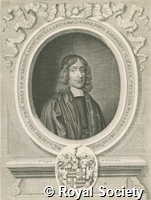| Authorised form of name | Bathurst; Ralph (1620 - 1704); physician |
| Dates | 1620 - 1704 |
| Nationality | British |
| Place of birth | Hothorpe, in the parish of Thedingworth, Northamptonshire, England, Europe |
| Date of birth | 1620 |
| Place of death | Oxford, Oxfordshire, England, Europe |
| Date of death | 14 June 1704 |
| Activity | Education:
Free School, Coventry; Gloucester Hall, Oxford; Trinity College, Oxford (BA 1638; MA 1641; BMed 1653; DMed 1654)
Career:
Fellow of Trinity College (1640); ordained priest (1644); at the Civil War ceased to act as a priest and became a physician; Physician to the Navy; Chaplain to the King (1663); President of Trinity College, Oxford (1664) and benefactor of the college; Rector of Garsington, Oxfordshire (1664); Dean of Wells (1670); Vice-chancellor of Oxford University (1673-1676); offered and refused bishopric of Bristol (1691); became blind towards the end of his life and died after breaking his thighbone while walking alone in Trinity College gardens
|
| Membership category | Fellow |
| Date of election | 19/08/1663 |
| RSActivity | Committee and panels:
Mechanical Committee (1664) ; Committee for Collecting all the Phenomena of Nature hitherto observed (1664) |
| Other Royal Society activity | Admitted on the same day as elected |
| Relationships | Parents: George Bathurst and Elizabeth Villiers
Siblings: sixteen in total, six of which died in the Civil War for the Royalist cause
Married: Mary Palmer (née Tristram)
Additional relatives: nephew Allen Bathurst, 1st Earl Bathurst |
| OtherInfo | Bathurst was not particularly active within the work of the Royal Society in London and was listed amongst 'absent members' in 1674. He was, however, a close friend of Thomas Willis (FRS 1663), with whom he assisted William Petty (FRS 1660) in the resuscitation of Anne Greene. Some of his poetry survives in the ensuing pamphlet 'Newes from the Dead' (1651), as well as in prefatory verses to Thomas Hobbes' 'Human Nature' (1650) and panegyrics to Charles I, Oliver Cromwell, and Charles II. Bathurst was involved in the fund-raising and execution of various building projects in Trinity College, Oxford. He invested £2,000 of his own money into the building of a baroque chapel at Trinity. Overall, he was remembered as a strong supporter of correspondence with intellectual figures so as to help the learning environment at Trinity flourish. |
| Related images | Discover a selection of related images in our picture library |
| Image | 
|
| Source | Sources:
Bulloch's Roll; DNB; Foster; ODNB
References:
Robert G Frank, Jr, 'John Aubrey, FRS, John Lydall, and Science at Commonwealth Oxford' in NR 1972-3 vol 27 pp 193-217 |
| Virtual International Authority File | http://viaf.org/viaf/11462035 |
| Code | NA8119 |